The Greasy Pole Syndrome in Alliaria petiolata (Brassicaceae): The Pubescence and Wax Coverage on Stems Reduce Invasion by Lasius niger Ants
Abstract
1. Introduction
2. Results
2.1. Micromorphology of Plant Surfaces
2.2. Frequencies of Ant Visits to Stem Samples
2.3. Locomotory Behavior, Travelled Distance, and Running Velocity of Ants on Stem Samples
3. Discussion
4. Materials and Methods
4.1. Plant and Insect Species
4.2. Microscopy
4.3. Experiments
4.3.1. Experiment I: Visiting Frequency
4.3.2. Experiment II: Locomotory Behavior of Ants
Supplementary Materials
Author Contributions
Funding
Data Availability Statement
Acknowledgments
Conflicts of Interest
References
- Rico-Gray, V.; Oliveira, P.S. The Ecology and Evolution of Ant-plant Interactions; University of Chicago Press: Chicago, IL, USA, 2007. [Google Scholar]
- Del-Claro, K.; Torezan-Silingardi, H.-M. In search of unusual interactions. A commentary on: ‘Pollen adaptation to ant pollination: A case study from the Proteaceae’. Ann. Bot. 2020, 126, IV–V. [Google Scholar] [CrossRef]
- Hickman, J.C. Pollination by ants: A low-energy system. Science 1974, 184, 1290–1292. [Google Scholar] [CrossRef]
- Beattie, A.J. The Evolutionary Ecology of Ant-plant Mutualisms; Cambridge University Press: New York, NY, USA, 1985. [Google Scholar]
- de Vega, C.; Arista, M.; Ortiz, P.L.; Herrera, C.M.; Talavera, S. The ant-pollination system of Cytinus hypocistis (Cytinaceae), a Mediterranean root holoparasite. Ann. Bot. 2009, 103, 1065–1075. [Google Scholar] [CrossRef] [PubMed]
- Del-Claro, K.; Rodriguez-Morales, D.; Calixto, E.S.; Martins, A.S.; Torezan-Silingardi, H.M. Ant pollination of Paepalanthus lundii (Eriocaulaceae) in Brazilian savanna. Ann. Bot. 2019, 123, 1159–1165. [Google Scholar] [CrossRef]
- Tsuji, K.; Hasyim, A.; Harlion; Nakamura, K. Asian weaver ants, Oecophylla smaragdina, and their repelling of pollinators. Ecol. Res. 2004, 19, 669–673. [Google Scholar] [CrossRef]
- Ness, J.H. A mutualism’s indirect costs: The most aggressive plant bodyguards also deter pollinators. Oikos 2006, 113, 506–514. [Google Scholar] [CrossRef]
- Junker, R.; Chung, A.Y.C.; Blüthgen, N. Interaction between flowers, ants and pollinators: Additional evidence for floral repellence against ants. Ecol. Res. 2007, 22, 665–670. [Google Scholar] [CrossRef]
- Lach, L. Argentine ants displace floral arthropods in a biodiversity hotspot. Divers. Distrib. 2008, 14, 281–290. [Google Scholar] [CrossRef]
- Cembrowski, A.R.; Tan, M.G.; Thomson, J.D.; Frederickson, M.E. Ants and ant scent reduce bumblebee pollination of artificial flowers. Am. Nat. 2014, 183, 133–139. [Google Scholar] [CrossRef]
- Sinu, P.A.; Sibisha, V.C.; Nikhila Reshmi, M.V.; Reshmi, K.S.; Jasna, T.V.; Aswathi, K.; Megha, P.P. Invasive ant (Anoplolepis gracilipes) disrupts pollination in pumpkin. Biol. Invasions 2017, 19, 2599–2607. [Google Scholar] [CrossRef]
- Unni, A.P.; Mir, S.H.; Rajesh, T.P.; Ballullaya, U.P.; Jose, T.; Palatty Allesh Sinu, P.A. Native and invasive ants affect floral visits of pollinating honey bees in pumpkin flowers (Cucurbita maxima). Sci. Rep. 2021, 11, 4781. [Google Scholar] [CrossRef]
- Carvalho, D.A.; Costa, L.M.; Silva, I.M.; Amoza, N.A.; Sendoya, S.F.; Cavalleri, A. Beyond nectar: Exploring the effects of ant presence on the interaction of fower visitors of a rosette in grassland. Arthropod-Plant Interact. 2024, 18, 469–478. [Google Scholar] [CrossRef]
- Galen, C. The effects of nectar thieving ants on seedset in floral scent morphs of Polemonium viscosum. Oikos 1983, 41, 245–249. [Google Scholar] [CrossRef]
- Hooks, C.; Espíndola, A. Ant Influences on Pollination and Some Other Plant Services. Maryland Agronomy News 2023. Available online: https://blog.umd.edu/agronomynews/2020/08/25/ant-influences-on-pollination-and-some-other-plant-services (accessed on 8 February 2024).
- Janzen, D.H. Why don’t ants visit flowers? Biotropica 1977, 9, 252. [Google Scholar] [CrossRef]
- Guerrant, E.O.; Fiedler, P.L. Flower defenses against nectar-pilferage by ants. Biotropica 1981, 13, 25–33. [Google Scholar] [CrossRef]
- Junker, R.R.; Blüthgen, N. Floral scents repel potentially nectar-thieving ants. Evol. Ecol. Res. 2008, 10, 295–308. [Google Scholar]
- Tagawa, K. Repellence of nectar-thieving ants by a physical barrier: Adaptive role of petal hairs on Menyanthes trifoliata (Menyanthaceae). J. Asia Pac. Entomol. 2018, 21, 1211–1214. [Google Scholar] [CrossRef]
- Weber, M.G.; Porturas, L.D.; Keeler, K.H. World List of Plants with Extrafloral Nectaries. Available online: www.extrafloralnectaries.org (accessed on 8 February 2024).
- Vilamil, N.; Boege, K.; Stone, G.N. Testing the distraction hypothesis: Do extrafloral nectaries reduce ant-pollinator conflict? J. Ecol. 2019, 107, 1377–1391. [Google Scholar] [CrossRef] [PubMed]
- Kerner von Marilaun, A. Flowers and their Unbidden Guests; C. Kegan Paul & Co.: London, UK, 1878. [Google Scholar]
- Harley, R.M. Evolution and distribution of Eriope (Labiatae) and its relatives in Brazil. In Proceedings of the Workshop on Neotropical Distributions, Academia Brasileira de Ciencias, Rio de Janeiro, Brazil, 12–16 January 1988; pp. 71–120. [Google Scholar]
- Harley, R. The greasy pole syndrome. In Ant-Plant Interactions; Huxley, C.R., Cutler, D.E., Eds.; Oxford University Press: Oxford, UK, 1991; pp. 430–433. [Google Scholar]
- Juniper, B.E. Waxes on plant surfaces and their interactions with insects. In Waxes: Chemistry, Molecular Biology and Functions; Hamilton, R.J., Ed.; Oily Press West Ferry: Dundee, UK, 1995; pp. 157–174. [Google Scholar]
- Gorb, E.; Gorb, S. How a lack of choice can force ants to climb up waxy plant stems. Arthropod-Plant Interact. 2011, 5, 297–306. [Google Scholar] [CrossRef]
- Gorb, S.N.; Gorb, E.V. Frequency of plant visits by the generalist ant Lasius niger depends on the surface microstructure of plant stems. Arthropod-Plant Interact. 2019, 13, 311–320. [Google Scholar] [CrossRef]
- Gorb, E.V.; Gorb, S.N. Frictional properties of flower stems in the plant Hippeastrum reginae (Amaryllidaceae). Appl. Phys. A 2020, 126, 549. [Google Scholar] [CrossRef]
- Gorb, E.V.; Gorb, S.N. Combined effect of different flower stem features on the visiting frequency of the generalist ant Lasius niger: An experimental study. Insects 2021, 12, 1026. [Google Scholar] [CrossRef]
- Cavers, P.V.; Heagy, M.I..; Kokron, R.F. The biology of Canadian weeds. 35. Alliaria petiolata (M. Bieb.) Cavara and Grande. Can. J. Plant Sci. 1979, 59, 217–229. [Google Scholar] [CrossRef]
- de Vega, C.; Herrera, C.M.; Dötterl, S. Floral volatiles play a key role in specialized ant pollination. PPEES 2014, 16, 32–42. [Google Scholar] [CrossRef]
- Domingos-Melo, A.; Nadia, T.L.; Machado, I.C. Complex flowers and rare pollinators: Does ant pollination in Ditassa show a stable system in Asclepiadoideae (Apocynaceae)? Arthropod-Plant Interact. 2017, 11, 339–349. [Google Scholar] [CrossRef]
- Potts, S.G.; Imperatriz-Fonseca, V.; Ngo, H.T.; Aizen, M.A.; Biesmejer, J.C.; Breeze, T.D.; Dicks, L.V.; Garibaldi, L.A.; Hill, R.; Settele, J.; et al. Safeguarding pollinators and their values to human well-being. Nature 2016, 540, 220–229. [Google Scholar] [CrossRef] [PubMed]
- Delnevo, N.; van Etten, E.J.; Clemente, N.; Fogu, L.; Pavarani, E.; Byrne, M.; Stock, W.D. Pollen adaptation to ant pollination: A case study from the Proteaceae. Ann. Bot. 2020, 126, 377–389. [Google Scholar] [CrossRef]
- Barthlott, W.; Neinhuis, C.; Cutler, D.; Ditsch, F.; Meusel, I.; Theisen, I.; Wilhelmi, H. Classification and terminology of plant epicuticular waxes. Bot. J. Linn. Soc. 1998, 126, 237–260. [Google Scholar] [CrossRef]
- Eigenbrode, S.D. Plant surface waxes and insect behaviour. In Plant Cuticles—An Integrated Functional Approach; Kerstiens, G., Ed.; BIOS Scientific Publishers: Oxford, UK, 1996; pp. 201–222. [Google Scholar]
- Müller, C. Plant-insect interactions on cuticular surfaces. In Biology of the Plant Cuticle; Riederer, M., Müller, C., Eds.; Blackwell: Oxford, UK, 2006; pp. 398–422. [Google Scholar]
- Gorb, E.V.; Gorb, S.N. Anti-adhesive effects of plant wax coverage on insect attachment. J. Exp. Bot. 2017, 68, 5323–5337. [Google Scholar] [CrossRef]
- Juniper, B.E.; Robins, R.J.; Joel, D.M. The Carnivorous Plants; Academic Press: London, UK, 1989. [Google Scholar]
- Gorb, E.; Haas, K.; Henrich, A.; Enders, S.; Barbakadze, N.; Gorb, S. Composite structure of the crystalline epicuticular wax layer of the slippery zone in the pitchers of the carnivorous plant Nepenthes alata and its effect on insect attachment. J. Exp. Biol. 2005, 208, 4651–4662. [Google Scholar] [CrossRef]
- Oelschlägel, B.; Gorb, S.; Wanke, S.; Neinhuis, C. Structure and biomechanics of trapping flower trichomes and their role in the pollination biology of Aristolochia plants (Aristolochiaceae). New Phytol. 2009, 184, 988–1002. [Google Scholar] [CrossRef] [PubMed]
- Poppinga, S.; Koch, K.; Bohn, H.F.; Barthlott, W. Comparative and functional morphology of hierarchically structured antiadhesive surfaces in carnivorous plants and kettle trap flowers. Funct. Plant Biol. 2010, 37, 952–961. [Google Scholar] [CrossRef]
- Gorb, E.V.; Dai, Z.; Gorb, S.N. Micromorphology of stem surface in three species of Bambusa (Poaceae, Bambusoideae) with a focus on its impact on plant-insect interactions. Flora 2017, 230, 14–25. [Google Scholar] [CrossRef]
- Gorb, E.V.; Gorb, S.N. Attachment ability of the beetle Chrysolina fastuosa on various plant surfaces. Entomol. Exp. Appl. 2002, 105, 13–28. [Google Scholar] [CrossRef]
- Gorb, E.V.; Purtov, J.; Gorb, S.N. Adhesion force measurements on the two wax layers of the waxy zone in Nepenthes alata pitchers. Sci. Rep. 2014, 4, 5154. [Google Scholar] [CrossRef] [PubMed]
- Gorb, E.V.; Hofmann, P.; Filippov, A.E.; Gorb, S.N. Oil adsorption ability of three-dimensional epicuticular wax coverages in plants. Sci. Rep. 2017, 7, 45483. [Google Scholar] [CrossRef] [PubMed]
- Voigt, D.; Gorb, E.; Gorb, S. Plant surface-bug interactions: Dicyphus errans stalking along trichomes. Arthropod-Plant Interact. 2007, 1, 221–243. [Google Scholar] [CrossRef]
- Voigt, D.; Gorb, E.; Gorb, S. Hierarchical organisation of the trap in the protocarnivorous plant Roridula gorgonias (Roridulaceae). J. Exp. Biol. 2009, 212, 3184–3191. [Google Scholar] [CrossRef] [PubMed][Green Version]
- Voigt, D.; Perez-Goodwyn, P.; Fujisaki, K. Attachment ability of the southern green stink bug, Nezara viridula (L.), on plant surfaces. Arthropod-Plant Interact. 2018, 12, 415–421. [Google Scholar] [CrossRef]
- Salerno, G.; Rebora, M.; Gorb, E.; Gorb, S. Attachment ability of the polyphagous bug Nezara viridula (Heteroptera: Pentatomidae) to different host plant surfaces. Sci. Rep. 2018, 8, 10975. [Google Scholar] [CrossRef]
- Markgraf, F. Familie Cruciferae. In Illustrierte Flora von Mitteleuropa, 2nd ed.; Hegi, G., Ed.; Verlag Carl Hanser: München, Germany, 1958; Volume IV, Part 1; pp. 118–120. [Google Scholar]
- Alliaria petiolata (M. Bieb.) Cavara & Grande. Available online: https://powo.science.kew.org/taxon/urn:lsid:ipni.org:names:1176324-2 (accessed on 8 February 2024).
- Alliaria petiolata (M. Bieb.) Cavara & Grande. Available online: http://tn-grin.nat.tn/gringlobal/taxon/taxonomydetail?id=2210 (accessed on 8 February 2024).
- Hoelldobler, B.; Wilson, E.O. The Ants; Harvard University Press: Cambridge, MA, USA, 1990. [Google Scholar]
- Klotz, J.H.; Hansen, L.; Pospischil, R.; Rust, M. Urban Ants of North America and Europe: Identification, Biology, and Management; Cornell University Press: Ithaca, NY, USA, 2008. [Google Scholar]
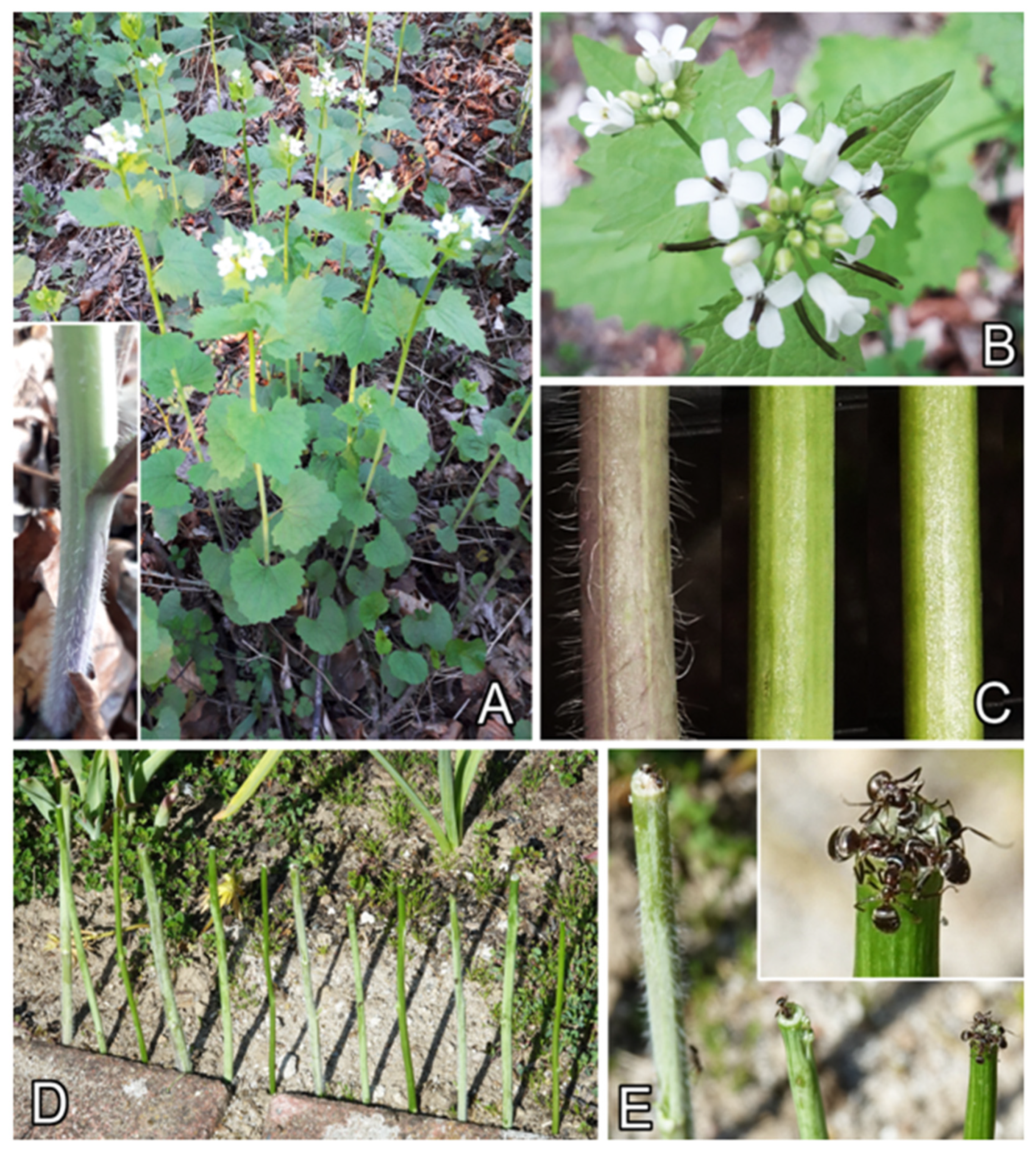
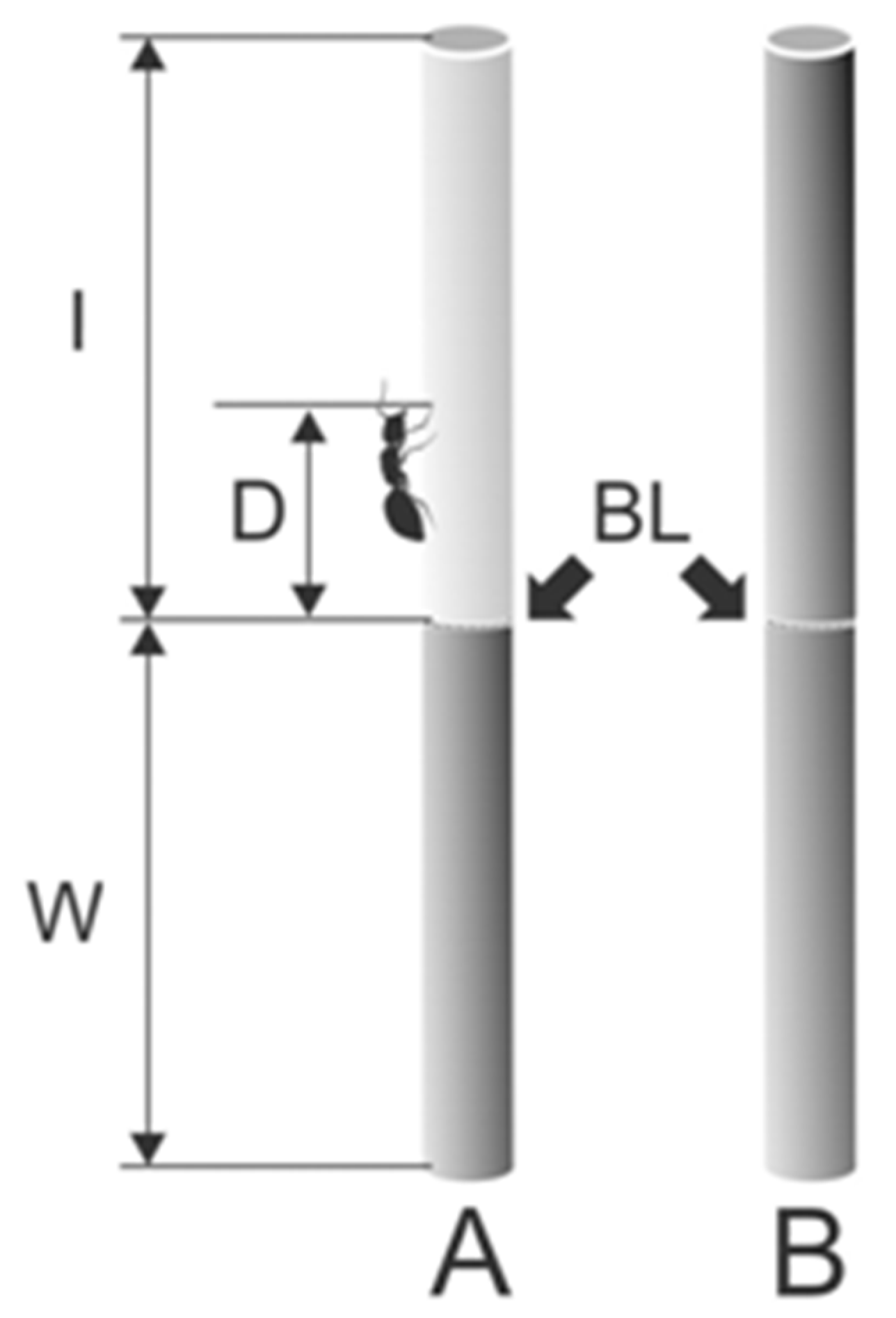
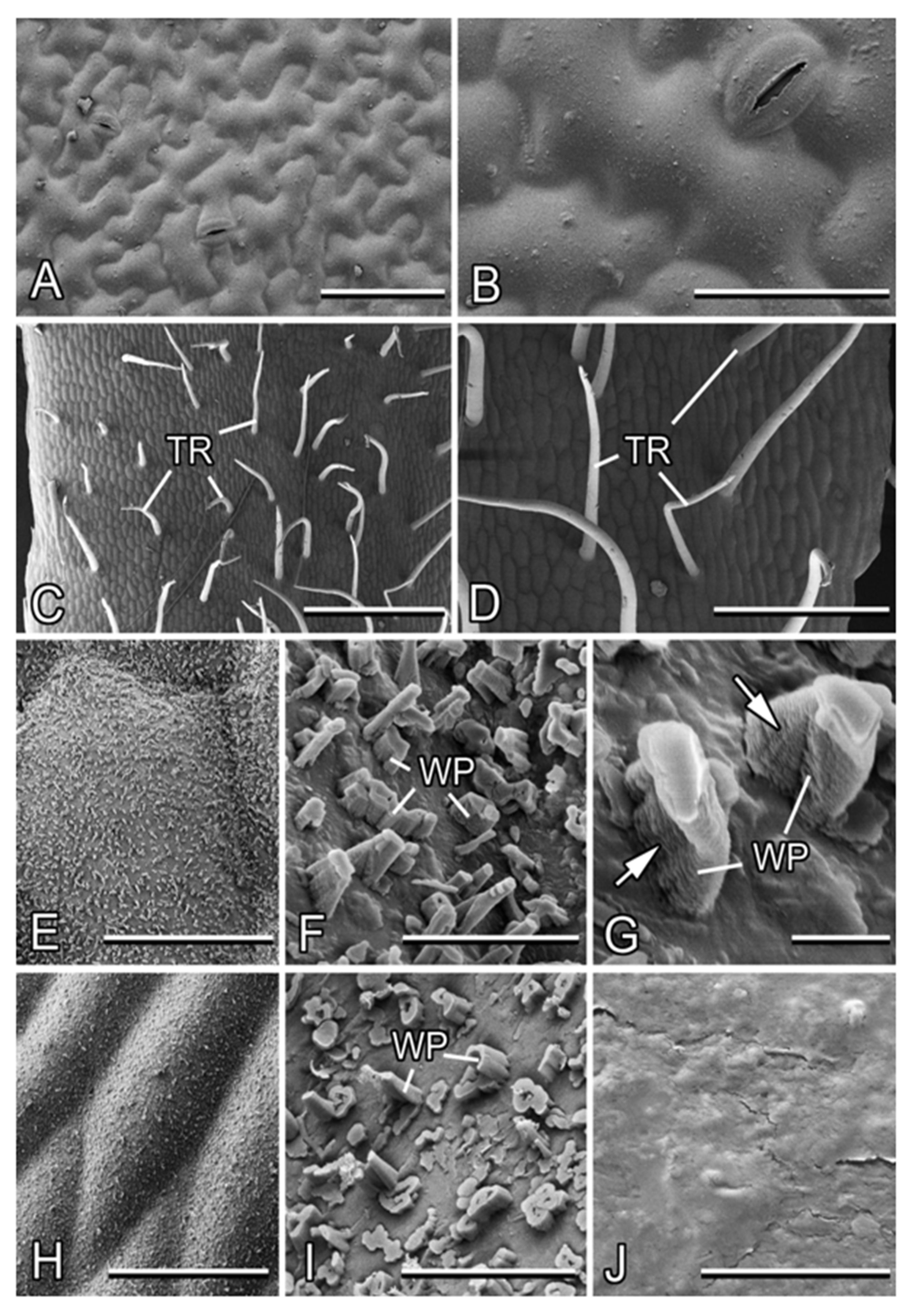
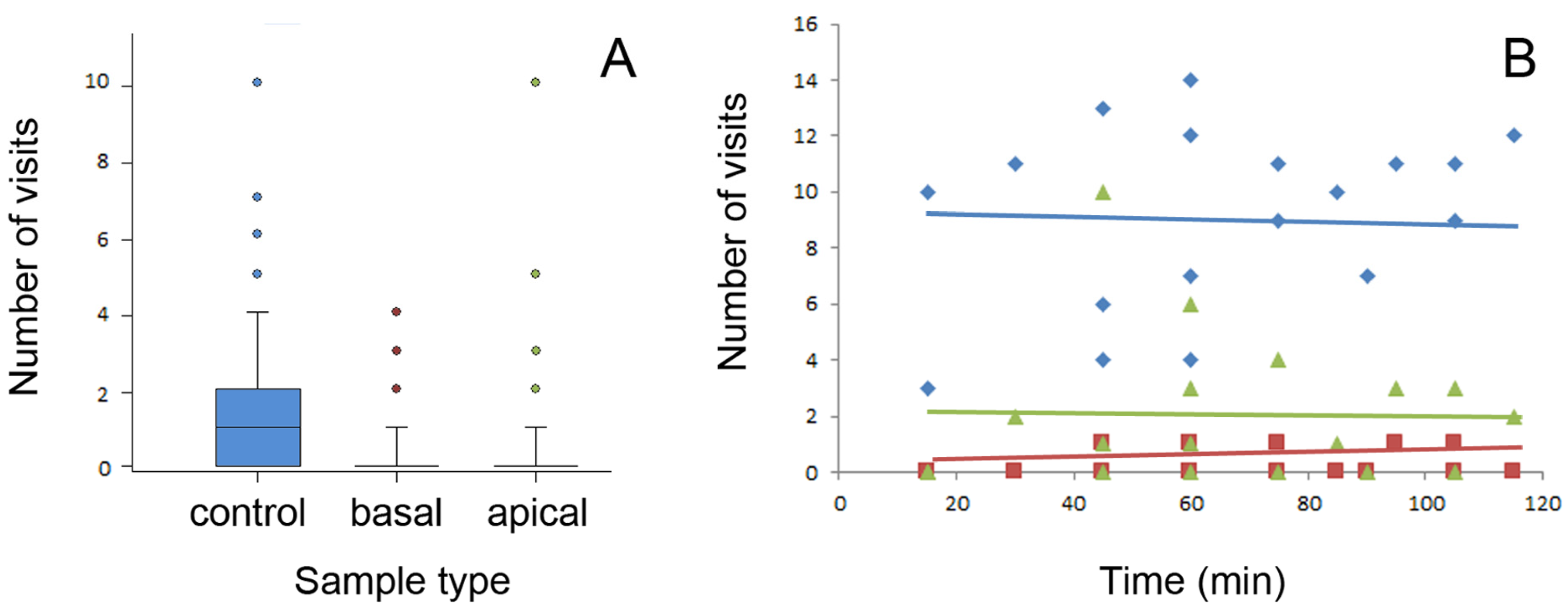
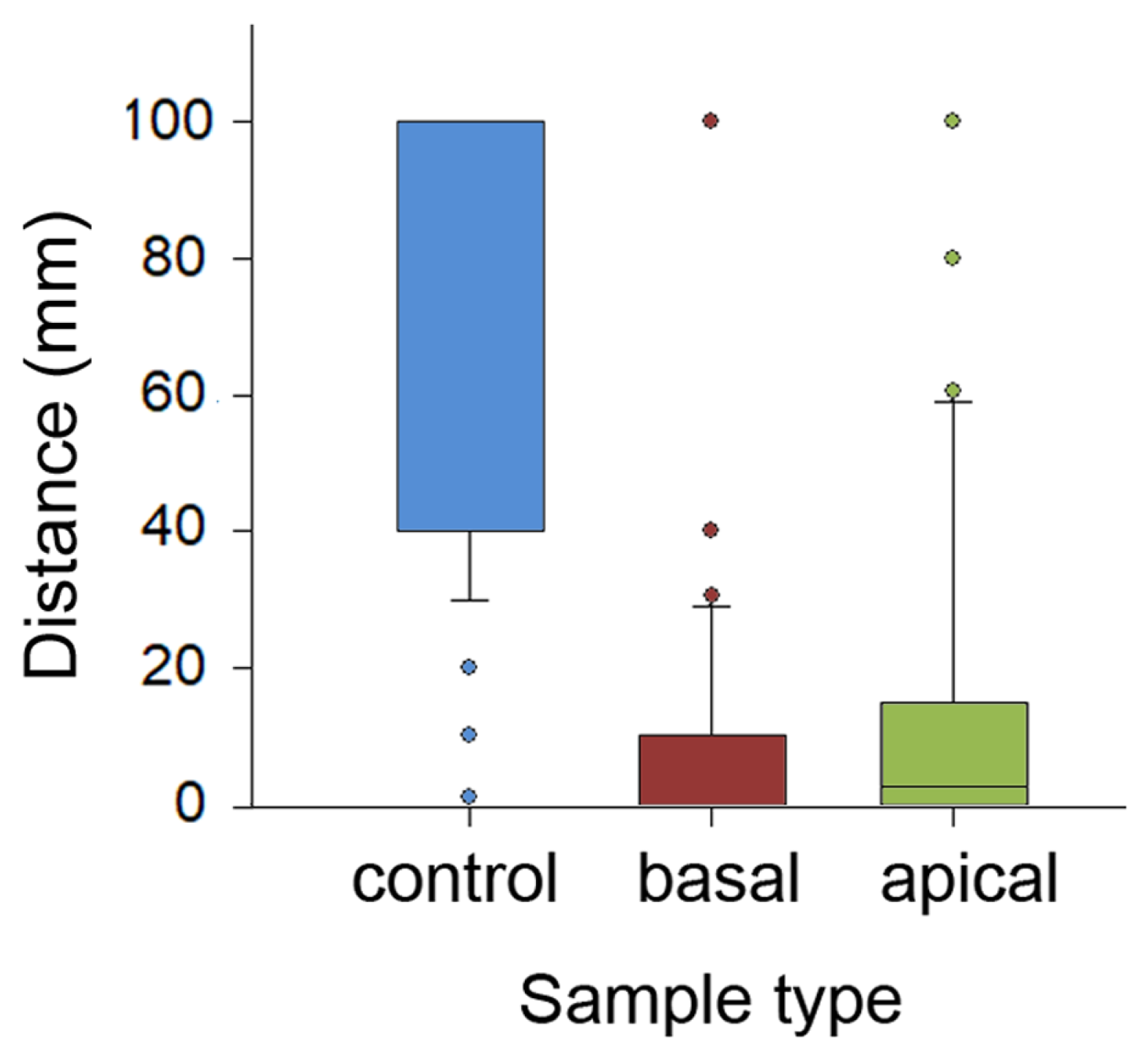
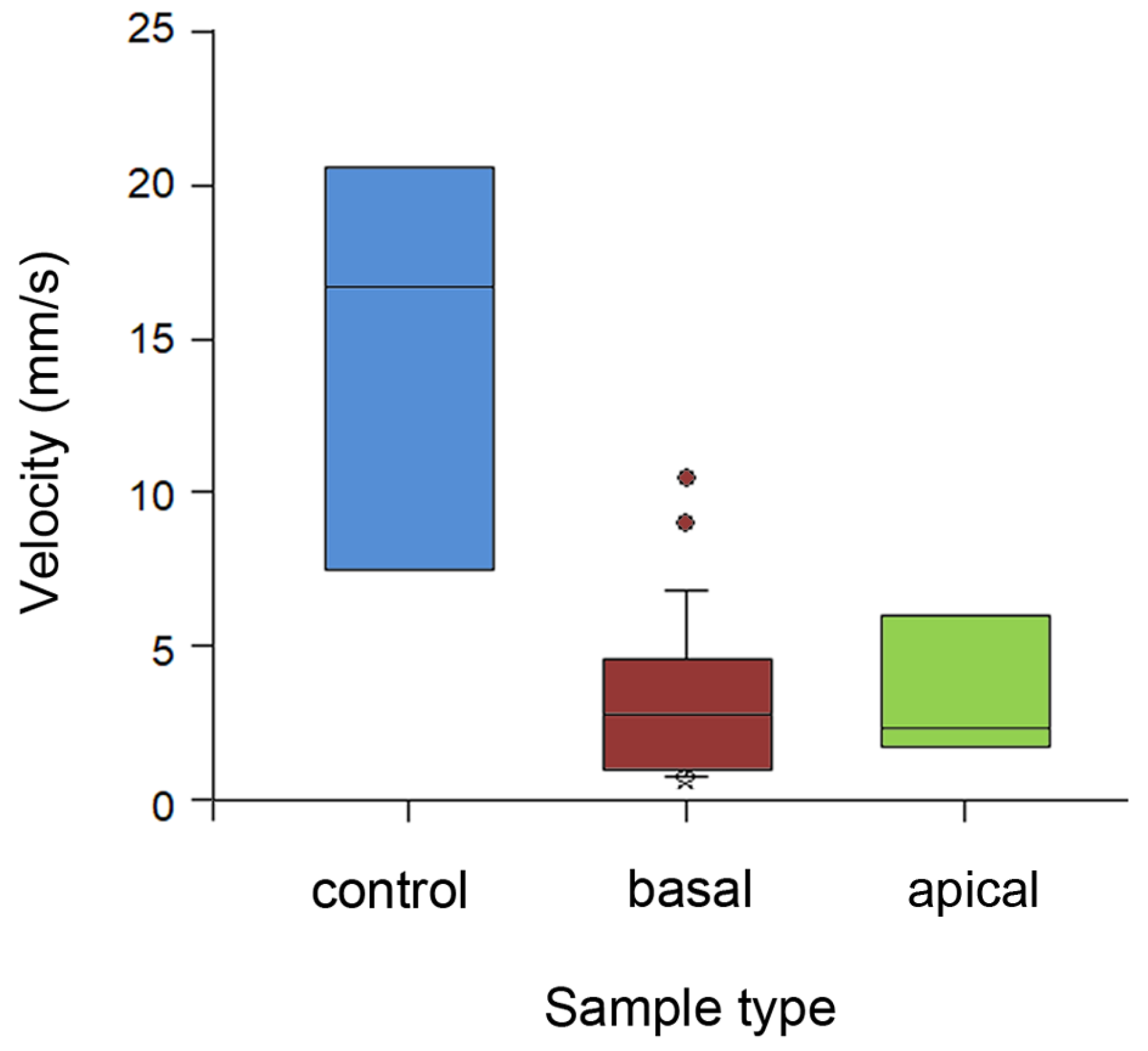
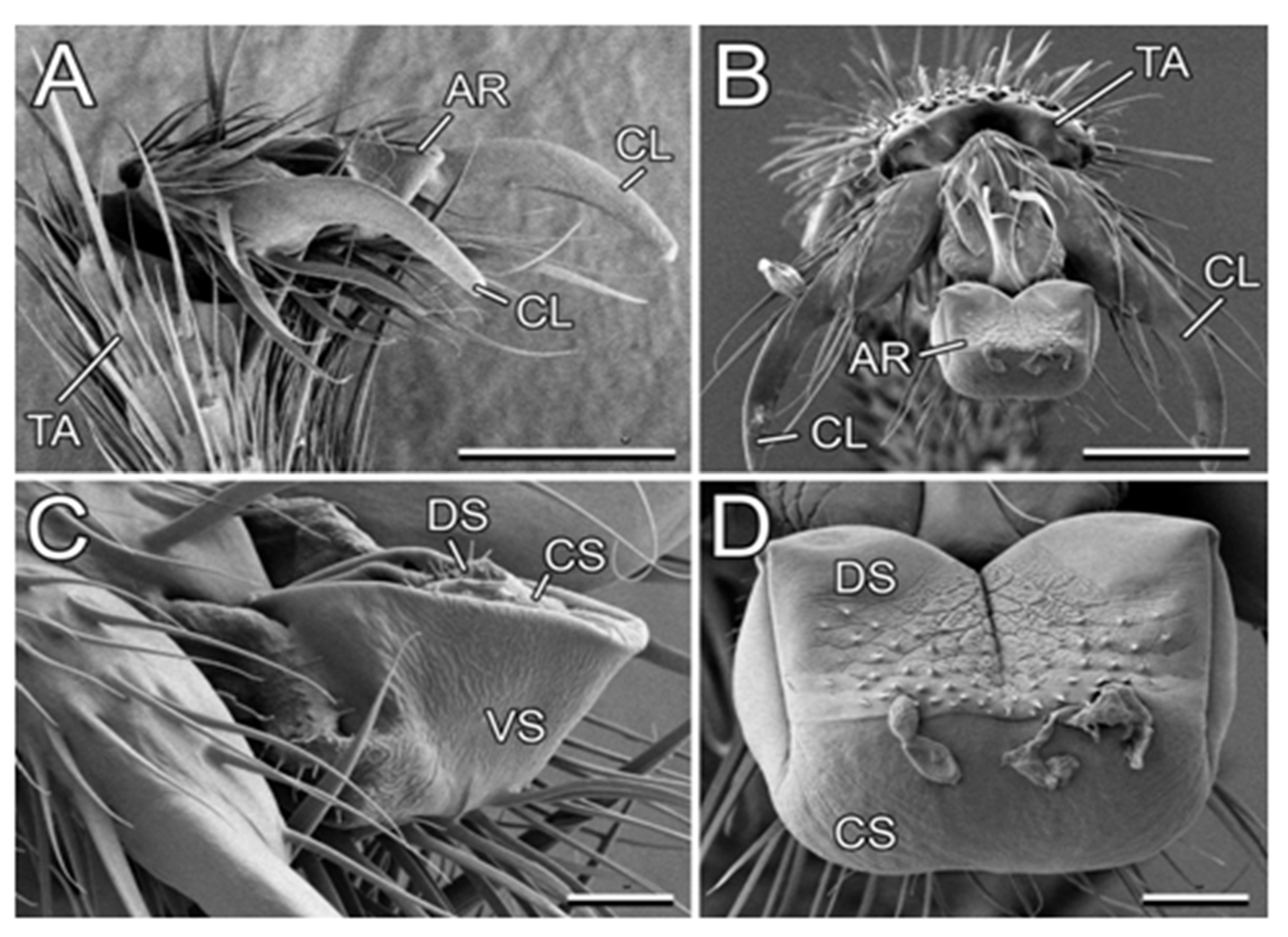
Disclaimer/Publisher’s Note: The statements, opinions and data contained in all publications are solely those of the individual author(s) and contributor(s) and not of MDPI and/or the editor(s). MDPI and/or the editor(s) disclaim responsibility for any injury to people or property resulting from any ideas, methods, instructions or products referred to in the content. |
© 2024 by the authors. Licensee MDPI, Basel, Switzerland. This article is an open access article distributed under the terms and conditions of the Creative Commons Attribution (CC BY) license (https://creativecommons.org/licenses/by/4.0/).
Share and Cite
Gorb, E.V.; Gorb, S.N. The Greasy Pole Syndrome in Alliaria petiolata (Brassicaceae): The Pubescence and Wax Coverage on Stems Reduce Invasion by Lasius niger Ants. Plants 2024, 13, 1932. https://doi.org/10.3390/plants13141932
Gorb EV, Gorb SN. The Greasy Pole Syndrome in Alliaria petiolata (Brassicaceae): The Pubescence and Wax Coverage on Stems Reduce Invasion by Lasius niger Ants. Plants. 2024; 13(14):1932. https://doi.org/10.3390/plants13141932
Chicago/Turabian StyleGorb, Elena V., and Stanislav N. Gorb. 2024. "The Greasy Pole Syndrome in Alliaria petiolata (Brassicaceae): The Pubescence and Wax Coverage on Stems Reduce Invasion by Lasius niger Ants" Plants 13, no. 14: 1932. https://doi.org/10.3390/plants13141932
APA StyleGorb, E. V., & Gorb, S. N. (2024). The Greasy Pole Syndrome in Alliaria petiolata (Brassicaceae): The Pubescence and Wax Coverage on Stems Reduce Invasion by Lasius niger Ants. Plants, 13(14), 1932. https://doi.org/10.3390/plants13141932






